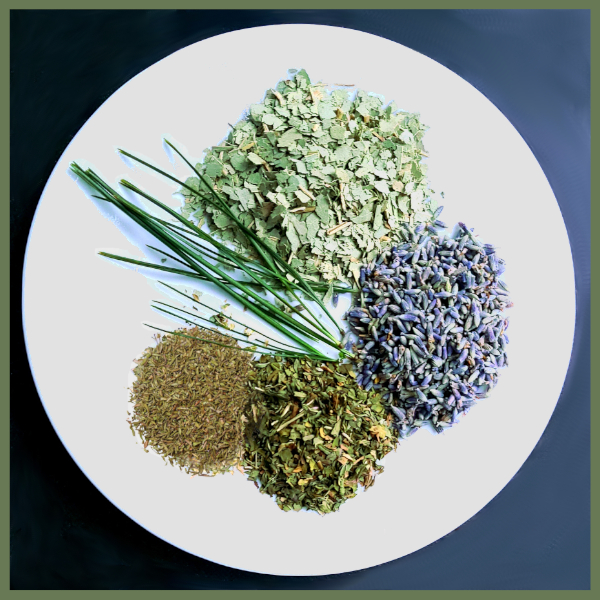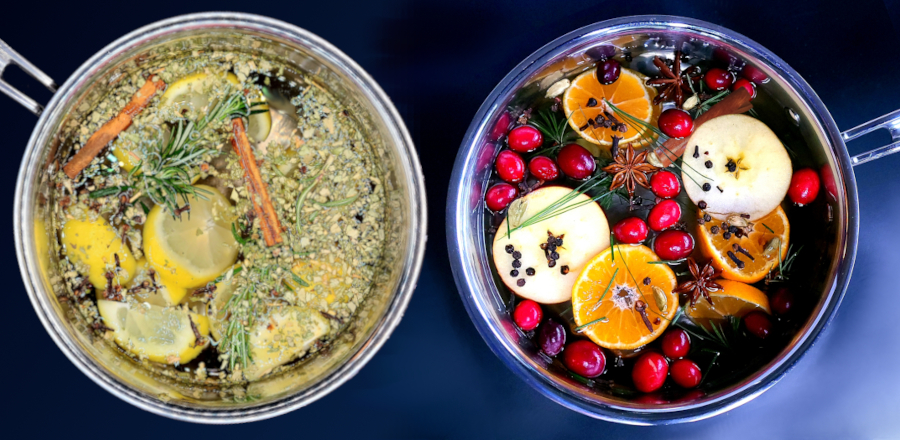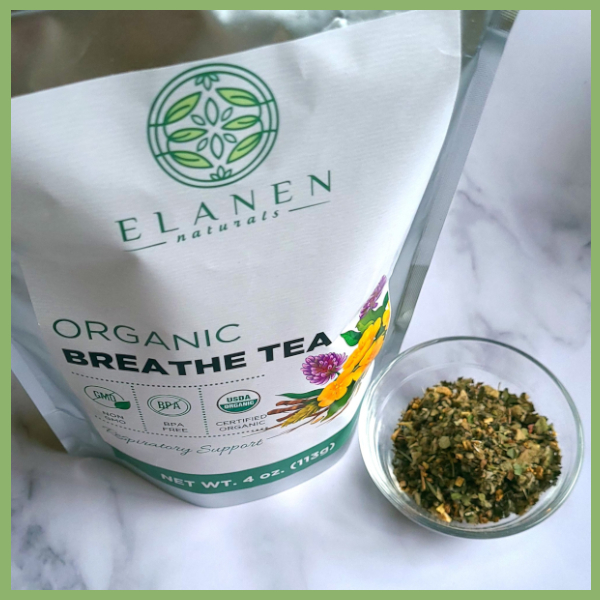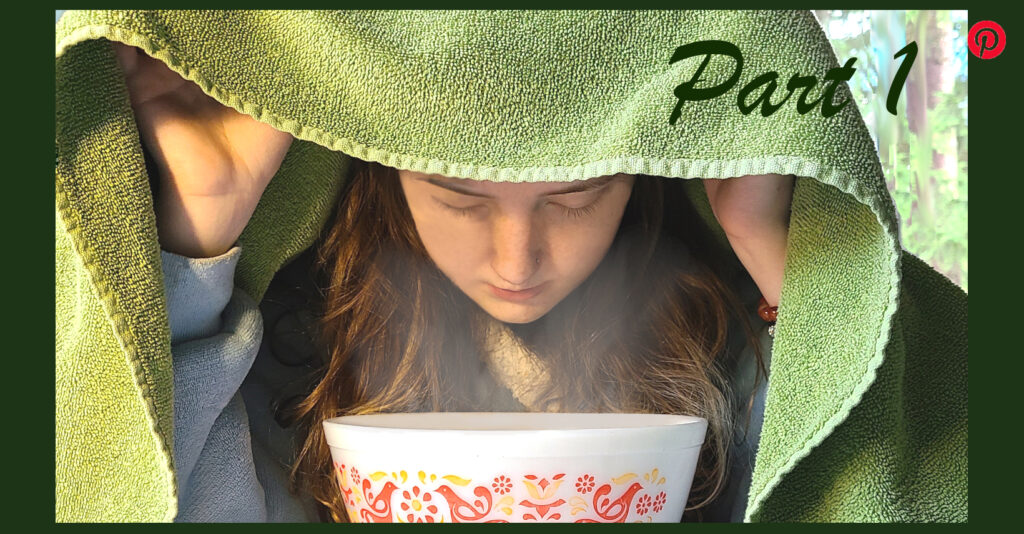
Ease Respiratory Cold Symptoms with a Soothing Herbal Steam
Anytime someone in my family starts showing respiratory cold symptoms, I make them a fresh inhaler to use as needed. I also encourage herbal steam inhalation to
- help loosen congestion,
- ease stuffiness,
- make coughs more productive, and
- provide moisture to irritated sinuses and mucous membranes.
Now, you don’t have to stick to only herbs in your steam blend. If desired, an herbal steam may also include a drop of decongesting essential oil or a cough and cold supporting essential oil blend. (Coming soon: Using essential oils in an herbal steam.)
While herbal steam inhalation does not treat a cold, it can provide temporary relief from upper respiratory cold symptoms.

[This post contains affiliate links. If you make a purchase through one of these links I may earn a commission. This does not impact your price. For more information, please see our disclosure.]
In this Herbal Steams Post:
Supplies Needed for Herbal Steams
Using an herbal steam is very simple, and a comforting way to soothe both upper and lower respiratory cold symptoms. This is what you’ll need:
- Medium to Large flat-bottomed, heat-proof bowl
- Small pot, electric kettle, or microwave-safe 4-cup liquid measuring cup
- 4 cups filtered water
- A small towel or hot pad (for under the bowl)
- A large towel (for tenting)
- 2-4 Tablespoons of herbs for steam inhalation (from list below)
- 1 drop essential oil or essential oil blend (see this post)
- Box of tissues…trust me, you’ll need it!
🔸Caution: Water should NOT be boiling when added to the herbs or inhaled—70-80°C (158-176°F) is a good temperature for steam inhalation. Water boils at 100°C (212°F).
Herbs for Steam Inhalation
The foundation of an herbal steam for coughs and respiratory colds is a blend of herbs with lots of volatile aromatics (they have a strong aroma) that open the breath. Along with the steam, the volatile aromatics help soothe upper respiratory cold symptoms and promote thinning of mucus in the nose and bronchial tubes.
These are my favorite herbs for steam inhalation:
- Eucalyptus – thins mucus, encourages expectoration, antimicrobial
- Pine, Fir, Spruce needles* – calming, decongesting, anti-inflammatory
- Thyme – encourages expectoration, antimicrobial
- Sage – helps thin mucus, anti-inflammatory, antimicrobial
- Rosemary – eases congestion, anti-inflammatory, antimicrobial
- Basil – decongesting, antimicrobial; skin care bonus
- Holy Basil/Tulsi – decongesting, antimicrobial
- Peppermint – cooling, helps thin mucus
- Spearmint – cooling, helps thin mucus, more gentle than Peppermint
- Lavender – calming, eases cough, anti-inflammatory; skin-soothing bonus
- Chamomile – calming, soothes upper respiratory cold symptoms; skin-soothing bonus
- Elderflower – cooling, soothes sinuses (also nice as a throat gargle!); skin-soothing bonus
- Orange Peel – drying, encourages expectoration
- Clove buds (just a few) – warming, encourages expectoration, decongesting, antimicrobial
- Cinnamon bark (smash with a kitchen mallet and use a shard or two) – warming, encourages expectoration, decongesting, antimicrobial
🌺See my Recommended Suppliers below
*Evergreen needles can be sustainably wildharvested. Unless you live in Antarctica, you likely have access to some type of evergreen tree. Look for Pines, Firs, and Spruces. When wildharvesting, select the tips that are in the interior of the tree, leaving the tips in the light to mature. Please take only what you need and thank the tree for sharing.
Learn something new about Face Steaming with Herbs.
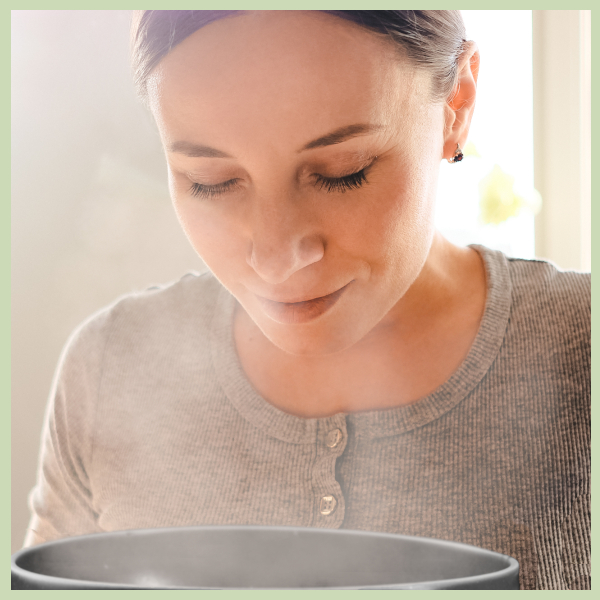
⭐️Family Favorite Herbal Steam Blend for Cough & Cold Symptoms
While I use a variety of herbs in my herbal steam blends, this is my family’s favorite.
I make a jar of this blend of dried herbs, so we always have it on hand to use the moment head or chest cold symptoms appear.
- 1 Tablespoon Eucalyptus leaves
- 1 Tablespoon Lavender flowers
- 2 teaspoons Peppermint leaves
- 1 teaspoon Thyme leaves
- (I usually add a few chopped fresh Pine needles, too)
🌺See my Recommended Suppliers below
How to Herbal Steam
- Take your bowl and herbs to a table where you can sit comfortably during the herbal steam session.
- Place the bowl on the small towel/hot pad to reduce sliding, prevent damage to the tabletop, and absorb any spilled water.
- Heat water to just boiling, then allow to sit for a couple of minutes. If using a microwave to heat your water, stir after removing from the microwave.
- Crush the herbs between your fingers to help release the aromatics.
- Pour the hot water over the freshly crushed herbs.
- If desired, add ONE drop of essential oil or essential oil blend.
- Make yourself comfortable. Then place the large towel over your head and lean over the bowl. Tent the towel over your head and bowl to create a steam inhalation chamber.
- Close your eyes. Inhale slowly—through the nose, if possible.
- If you find yourself overheating, simply lift the edge of the towel to vent the steam or take a break for a minute.
- Blow nose as needed.
- Steam for up to 10 minutes.
- After 10 minutes, rinse your face with cool water and pat dry.
- Let the water completely cool. Or transfer the entire contents to a pot and continue to benefit with a simmer pot.
- Add cooled water and herbs to compost bin. Alternatively, pour into your kitchen sink (with disposer) to do double duty as a sink deodorizer!
- Repeat at least 2 to 3 times daily, while symptoms persist. If congestion is severe or mucus is thick, steam inhalation can be repeated as often as every few hours. I like to use fresh herbs with each steam.
Kids and Herbal Steam Inhalation
The aromatics from an herbal steam are generally safe for tweens and under. I recommend, not tenting your child when doing an herbal steam. Rather just sit with them as they sit by/lean over the bowl. This allows you to stay in control of the bowl at all times and reduces the risk of hot water injury. It’s also a great time to gently pat their back to help loosen phlegm.
Favorite Herbal Steam Herbs for Kids
- Lavender
- Basil
- Orange Peel
- Evergreen needles.
We’ll be talking about Shower Steaming with Kids in an upcoming post.
Herbal Steam to Simmer Pot
My favorite way to make the most of these beautiful herbs is to pour the entire contents of the herbal steam bowl into a soup pot and bring to a simmer on the stove top. I keep it at a simmer through the day to help cleanse the air. Also, the additional moisture in the air is especially nice during the dry winter months. [Learn more about simmer pots.]

☀️Spotlight Product: Herbal Tea for Chest Cold Symptoms
Last year I had a bad cough with sore throat and chest congestion. My thoughtful friends at Elanen naturals sent me a bag of their organic Breathe Tea in a care package. Wow! What a beautiful blend of herbs.
Sipping the aromatic tea, I was aware of the delicious lemony scent of the Lemon Myrtle and Lemon Balm. The Licorice Root and Elderflower soothed and cooled my dry itchy throat. The Mullein and Plantain helped calm my cough. And the Ginger Root and Elecampane were warming and comforting.
In addition to soothing upper respiratory symptoms, Breathe Tea is great during allergy season.
We’ve been using it ever since, whenever upper respiratory allergy and cold symptoms appear. We add a generous teaspoon per 8-10oz hot water and steep covered for 5-10 minutes. It’s a very pleasant herbal tea and helps us feel so much better. I often swirl in a bit of herbal honey, too!

Do you have a particular herb that you find helpful for cough and cold symptoms? How do you use it? Please let us know in the comments below!

Additional Reading Suggestions
Thyme Herb & Essential Oil: Kowalczyk, A., Prychodna, M., Sopata, S., Bodalska, A., Fecka, I. (2020). Thymol and thyme essential oil—new insights into selected therapeutic applications. Molecules, 25(18):4125. https://doi.org/10.3390/molecules25184125
General Reference: de la Forêt, R., Han, E. (2020). Wild Remedies: How to forage healing foods and craft your own herbal medicine. Hay House, Inc. (Available on Amazon)


Mom’s Shopping List
You can find the culinary herbs, like Basil, Thyme, and Rosemary, at your local grocer. However, if you plan to use them regularly for herbal steams or simmer pots, buying in a larger volume may be more cost effective.
Most of my favorite herbs for herbal steams can be found on my Amazon Cough & Cold Care shopping list. These are my preferred suppliers for the herbs we use in our herbal steams.
- Basil Leaf (Ocimum basilicum):
- Mountain Rose Herbs, organic
- Homegrown from seed from Seed Needs (on Amazon)
- Local grocer, organic.
- Chamomile Flower (Matricaria chamomilla/M. recutita):
- Elanen naturals, organic (on Amazon)
- Starwest Botanicals, organic (on Amazon)
- homegrown from seed from Botanical Interests.
- Cinnamon Sticks (Cinnamomum spp):
- FGOrganics, organic (on Amazon)
- Mountain Rose Herbs, organic.
- Clove Buds (Eugenia caryophyllata/Syzygium aromaticum):
- Spice Train, climate neutral (on Amazon)
- Local grocer, organic.
- Elderflower (Sambucus nigra/S. ebulus):
- Elanen naturals, organic (on Amazon)
- Mountain Rose Herbs, organic.
- Eucalyptus Leaf (Eucalyptus globulus)
- Elanen naturals, organic (on Amazon)
- Mountain Rose Herbs, organic.
- Lavender Buds (Lavandula spp):
- FGOrganics, L. angustifolia, organic (on Amazon)
- Anthony’s Goods, Lavandula spp, organic (on Amazon).
- Peppermint Leaf (Mentha x piperita):
- Elanen naturals, organic (on Amazon)
- Mountain Rose Herbs, organic
- Rosemary Leaf (Rosmarinus officinalis/Salvia rosmarinus):
- Mountain Rose Herbs, organic
- Anthony’s Goods, organic (on Amazon)
- Local grocer, organic.
- Sage Leaf (Salvia officinalis):
- Mountain Rose Herbs, organic
- Local grocer, organic
- Homegrown from seed from Seed Needs (on Amazon) or Botanical Interests.
- Spearmint Leaf (Mentha spicata):
- Elanen naturals, organic (on Amazon)
- Mountain Rose Herbs, organic
- Homegrown from seed from Seed Needs (on Amazon).
- Tulsi/Holy Basil (Ocimum sanctum/O. tenuiflorum):
- Organic India, organic Tulsi blend (on Amazon)
- Starwest Botanicals, organic Tulsi blend
- Homegrown from seed from Botanical Interests.
This information has not been evaluated by the Food and Drug Administration and is not intended to diagnose, treat, cure, or prevent any disease. It is for educational purposes only.
All recipes provided are for personal use and are not designed for re-sale or large-scale manufacturing.
Please consult your doctor, naturopath, herbal practitioner, or other qualified health professional for medical advice and before starting any herbal regimen, particularly if you are pregnant or nursing, have any existing medical conditions, or are taking any medications.

Chris P | Author, Certified Aromatherapist, Natural Skin Care Formulator
Chris (“Mom”) enjoys formulating bespoke aromatherapy, skin care, and herbal products to support her family, pets, friends, and clients. She also loves experimenting with recipes in the kitchen. An avid reader, writer, and lifetime learner, Chris enthusiastically explores research rabbit holes and then writes about her discoveries.💚 (Learn more >>)


